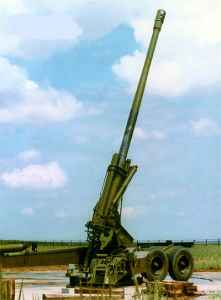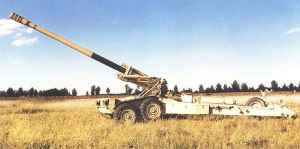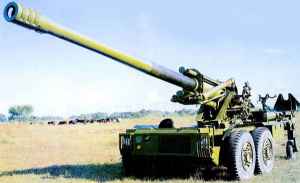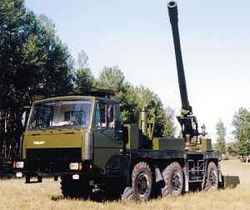| Designation: | PLL01 |
 |
|---|---|---|
| Manufacturer: | NORINCO - China North Industries Group Corporation - CNGC | |
| Product type: | Weapons & Weapon Systems | |
| Name: | Towed howitzer |
The PLL01 (also known as W88/890) is a heavy gun-howitzer introduced in 1987 by the China North Industries Group Corporation (CNGC). It was the first PLA artillery system to have adopted the Western-standard 155mm calibre instead of the Soviet/Russian standard 152mm calibre. The weapon was briefly displayed to the public during the 1999 military parade held in Beijing to mark the 50th anniversary of the PRC, with a small number (~36) fielded by an artillery division subordinate to the Beijing Military Region. No further commission has been reported.
The PLL01 was based on the Austrian GHN-45, which itself was derived from the Canadian GC-45 howitzer designed by Dr Gerald Bull’s Space Research Corporation in the 1970s. The GC-45 combines a number of features to produce what is generally considered the best field artillery in the world. Its unique 155mm/45-calibre gun design has been adopted by a number of artillery systems around the world, including the famous South African G5 howitzer.
The PRC obtained the Austrian GHN-45 howitzer technology in the 1980s when it formed a temporary coalition with Western countries against the Soviet Union. The technology was used to develop the PRC’s own version of the 155mm/45-calibre howitzer known as W88. The howitzer was promoted to the export market under the designation WA021, and later adopted by the PLA under the designation PLL01. The weapon was also sometimes referred to as the W89 or Type 89. The PLL01/W88 design was also used on the PLZ45 self-propelled gun-howitzer system.
Design
The 155mm/45-calibre PLL01 matches the firepower of the PLA’s existing 17km-range Type 66 (Russian D-20 copy) 152mm gun-howitzer, but has a much extended firing range of 24km with unassisted rounds, or 30km with the extended-range full-bore (ERFB) rounds, or 39km with the extended-range full-bore base bleed (ERFB-BB) rounds. The minimum range is 5,400m.
The gun-howitzer is constructed using alloy steel. The muzzle velocity (using ERFB-BB projectile) is 903m/s. The PLL01 is able to deliver up to 4 rounds per minute under intense firing conditions and is able to provide a sustained rate of fire of 2 rounds per minute. The howitzer is capable of both direct (line of sight) and indirect (out of the line of sight) firing.
The PLL01 is fitted with a hydraulic power pack for operation of the load assist systems, for aiming and for opening/closing the carriage. When in travelling mode, the howitzer barrel is folded back 180 degree to reduce the total length of the howitzer from 13m to 9m.
The Type 89/PLL01 fires a range of projectiles, including the Extended-Range Full-Bore High Explosive (ERFB/HE), Extended-Range Full-Bore Base Bleed High Explosive (ERFB-BB/HE), ERFB-BB/RA, ERFB/WP, ERFB/Illuminating, ERFB/Smoke, and ERFB-BB/Cargo.
China obtained the Russian Krasnopol laser-guided projectile technology in the 1990s, and has successfully developed its own 152/155mm laser-guided ammunitions. Designed to defeat armoured vehicles and weapon emplacements, the projectile has inertial mid-course guidance and semi-active laser homing. The projectile has a range of 3~20km, and can hit a target by the first shot without registration.
An auxiliary power unit (APU) has been developed for the PLL01/W88 to provide limited self-propel capability. The 77hp APU can support the howitzer to travel up to 80km at a speed of 18km/h. When towed by trucks, the APU could also help the howitzer in cross-country travelling.
The PLL01 has a combat weight of 12,000kg (with APU) and 9,800kg (without APU). The howitzer can be towed by an air-braked 6X6 truck. The carriage has 4 large wheels and 2 small support wheels and is fitted with hydrostrut suspension system. The maximum road speed is 90km/h.
CNGC also introduced the lightweight GM-45 155mm gun-howitzer, which is fitted on the two-wheel carriage of the Type 59-I 130mm field gun. By using the carriage of an existing artillery system, the GM-45 can reduce its combat weight and lower the unit cost. However, the lighter carriage of the GM-45 also results in less stable platform when firing, causing lower fire accuracy. The GM-45 was tailored for the export market in some third-world countries, but has received no order.
In 2001, a truck-mounted variant of the 155mm gun-howitzer system was introduced. The design did not enter production, with only a technical demonstrate sample produced.
|
||||||
 |
 |
 |
 |
 |
 |
 |
